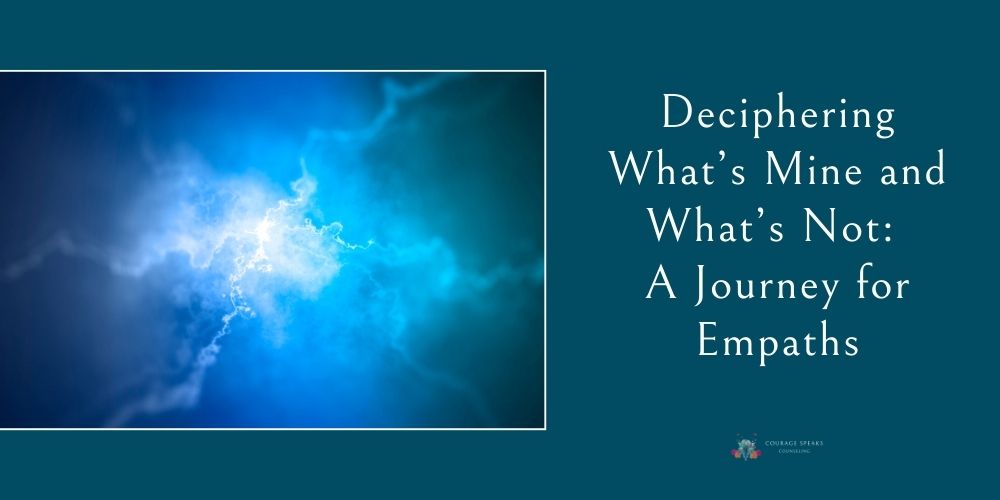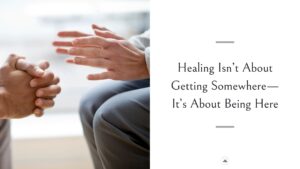
Before, After, and Now: Healing After Life-Altering Events
Healing isn’t about returning to who you were—it’s about learning to live fully in the present and trusting the unfolding of your journey after life-altering events.

For those who identify as empaths, the world can feel like an intense and overwhelming place. The emotions, thoughts, and energies of others seep in so easily that it becomes hard to separate what belongs to you from what belongs to someone else. As an empath, you might often find yourself absorbing the pain or joy of those around you, to the point where their emotional states feel like your own.
This ability to tune in deeply to others is a gift, but when not managed well, it can blur the boundaries between yourself and others. It can make you feel overly responsible for the emotional climate of a room, or it can leave you drained after spending time with others. So how do you decipher between what’s truly yours and what’s not?
Before you can begin to sort out what you’re absorbing from others, it’s crucial to understand your own emotional baseline. This requires slowing down and checking in with yourself regularly. Start by paying attention to your inner world before entering situations where you know emotions might run high. What are you feeling before stepping into someone else’s emotional energy?
This internal check-in helps you establish your own emotional starting point. Once you’re more in tune with what is naturally yours, it becomes easier to identify when a sudden shift occurs that doesn’t align with your prior emotional state. These shifts may signal that you’re picking up on something external.
Sometimes, the distinction between “mine” and “not mine” becomes complicated. When the emotions you pick up resonate with your own unresolved wounds, it can feel like they belong to you, even if they originated from someone else. If you’ve carried old hurts—perhaps feelings of abandonment, rejection, or unworthiness—those emotions can be triggered and magnified by what someone else is feeling.
For example, if a friend is experiencing deep loneliness and you’ve struggled with that same emotion in your past, you might absorb and amplify their loneliness to the point where it feels like your own. In these moments, it’s easy to get swept up in the emotion without recognizing it as a reflection of an unhealed part of yourself. This is why healing your own emotional wounds is so essential for an empath—it allows you to see more clearly what is truly yours.
Once you’ve begun to heal and understand your emotional landscape, setting compassionate boundaries is the next step. Boundaries are often misunderstood as walls meant to keep people out, but in reality, they are about protecting your own energy while still being able to show up authentically for others. They aren’t about telling someone else how to feel or behave—they’re about taking care of your own emotional health.
Setting these boundaries as an empath might look like limiting time in environments that drain you, or giving yourself permission to step away when you feel overwhelmed. It can also involve grounding practices that help you come back to yourself when you feel scattered by the emotions of others.
Empaths often need more intentional practices to maintain emotional and energetic boundaries. One common technique is visualization, where you imagine placing yourself inside a protective bubble before entering emotionally charged spaces. Picture a soft but strong light surrounding you, acting as a shield that lets in only what is necessary while keeping out what doesn’t serve you. Some people prefer to imagine standing inside a radiant sun, basking in its warmth and light before stepping into a crowd or challenging situation. The idea is to ground yourself in your own energy first, strengthening your sense of self before engaging with the energy of others.
In addition to these visualizations, physical practices can also be helpful. Before heading into emotionally intense situations, try taking deep, grounding breaths, or imagine roots extending from your feet into the earth, anchoring you. Some empaths also find that wearing or carrying grounding objects, like certain stones or crystals, offers an extra layer of support.
At the end of each day, it’s important to release what you’ve absorbed that isn’t yours. A simple visualization exercise can help you do this. Close your eyes, take a few deep breaths, and imagine returning everything you’ve picked up from others. You might visualize placing these emotions and energies into a box or a container and giving them back to the universe, allowing the weight to lift from your shoulders. Some people prefer to imagine washing these energies away with water—whether that’s through a shower or simply by washing your hands with cold water while setting the intention to release everything that doesn’t belong to you.
These rituals, though simple, create a daily habit of self-care that can prevent emotional buildup over time. It’s a way of clearing the slate each day so that you don’t carry others’ burdens long after an interaction has ended.
Being an empath doesn’t mean you’re doomed to carry the emotional burdens of others. It means you have a unique sensitivity that, when properly managed, can be a powerful tool for connection and compassion. The key is learning how to sift through what belongs to you and what belongs to others, allowing you to show up in the world with clarity and presence.
This journey is one of both self-compassion and self-awareness. It’s about healing the old wounds that cloud your understanding of your own emotional world. It’s about setting boundaries that are rooted in self-care.
Ultimately, deciphering what’s yours and what’s not is an ongoing practice. As you continue to heal, set boundaries, and use tools like visualizations and grounding exercises, you’ll find that the emotional world you once absorbed so easily becomes clearer, and you can navigate it with more ease and grace.
Embracing Shadows, Illuminating Hope,
Chelsey Fjeldheim, LCSW
Empowering Souls on the Path of Healing
Copyright © 2024 Chelsey Fjeldheim, Courage Speaks Counseling

Healing isn’t about returning to who you were—it’s about learning to live fully in the present and trusting the unfolding of your journey after life-altering events.

Healing isn’t about fixing yourself. It’s about staying present, feeling fully, and letting transformation happen without force.

There’s no perfect time to start therapy, but if you feel stuck, disconnected, or overwhelmed by change, it might be the right time to explore it.

Because you matter. You are important. You are worth it.